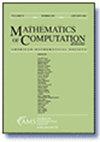关于有限的枚举𝐿-代数
IF 2.2
2区 数学
Q1 MATHEMATICS, APPLIED
引用次数: 0
摘要
我们使用约束满足方法来构造和枚举有限L-代数,直至同构。这些对象最近由Rump引入,出现在Garside理论、代数逻辑和组合杨-巴克斯特方程的研究中。大小为8的L-代数共有377322225个同构类。所构建的数据库表明,某些类的L-代数和已知的组合对象之间存在双射。我们证明了Bell数列举了有限线性L-代数的同构类。我们还证明了有限正则L-代数与无限维Young图是双射对应的。本文章由计算机程序翻译,如有差异,请以英文原文为准。
On the enumeration of finite 𝐿-algebras
We use Constraint Satisfaction Methods to construct and enumerate finite
L
L
-algebras up to isomorphism. These objects were recently introduced by Rump and appear in Garside theory, algebraic logic, and the study of the combinatorial Yang–Baxter equation. There are 377,322,225 isomorphism classes of
L
L
-algebras of size eight. The database constructed suggests the existence of bijections between certain classes of
L
L
-algebras and well-known combinatorial objects. We prove that Bell numbers enumerate isomorphism classes of finite linear
L
L
-algebras. We also prove that finite regular
L
L
-algebras are in bijective correspondence with infinite-dimensional Young diagrams.
求助全文
通过发布文献求助,成功后即可免费获取论文全文。
去求助
来源期刊

Mathematics of Computation
数学-应用数学
CiteScore
3.90
自引率
5.00%
发文量
55
审稿时长
7.0 months
期刊介绍:
All articles submitted to this journal are peer-reviewed. The AMS has a single blind peer-review process in which the reviewers know who the authors of the manuscript are, but the authors do not have access to the information on who the peer reviewers are.
This journal is devoted to research articles of the highest quality in computational mathematics. Areas covered include numerical analysis, computational discrete mathematics, including number theory, algebra and combinatorics, and related fields such as stochastic numerical methods. Articles must be of significant computational interest and contain original and substantial mathematical analysis or development of computational methodology.
 求助内容:
求助内容: 应助结果提醒方式:
应助结果提醒方式:


